Unit load device
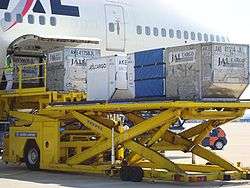
A unit load device (ULD) is a pallet or container used to load luggage, freight, and mail on wide-body aircraft and specific narrow-body aircraft. It allows a large quantity of cargo to be bundled into a single unit. Since this leads to fewer units to load, it saves ground crews time and effort and helps prevent delayed flights. Each ULD has its own packing list (or manifest) so that its contents can be tracked.
The IATA publishes ULD regulations and notes there are 900,000 in service worth more than one billion USD, averaging $1100 each.[1]
Types
ULDs come in two forms: pallets and containers. ULD pallets are rugged sheets of aluminum with rims designed to lock onto cargo net lugs. ULD containers, also known as cans and pods, are closed containers made of aluminum or combination of aluminum (frame) and Lexan (walls), which, depending on the nature of the goods to be transported, may have built-in refrigeration units. Examples of common ULDs and their specifics are listed below.
| type | internal volume |
height | depth | base width |
overall width |
width | contour | IATA | Suitability |
|---|---|---|---|---|---|---|---|---|---|
| LD3-45[3] | 3.7 m³ / 131 ft³ | 114.3/45 | 153.4/60.4 | 156.2/61.5 | 243.6/95.8 | Full | double | AKH | A320 |
| LD2 | 3.5 m³ 124 ft³ | 162.6/64 | 119.4/47 | 156.2/61.5 | Half | single | DPE | Boeing WB | |
| LD3 | 4.5 m3 / 159 ft3 | 156.2/61.5 | 200.7/79 | AKE | Airbus WB, Boeing WB, DC-10/MD-11, L-1011 | ||||
| LD1 | 5.0 m³ / 175 ft³ | 233.7/92 | AKC | Boeing WB, MD-11 | |||||
| LD4 | 5.7 m3 (200 ft3) | 243.8/96 | 243.8/96 | Full | none | ALP | 767, 777, 787 | ||
| LD8 (2×LD2) | 7.1 m3 / 252 ft3 | 317.5/125 | double | DQF | 767/787 | ||||
| LD11 | 7.2 m3 / 256 ft3 | 317.5/125 | none | ALP | 747, 777, 787, DC-10/MD-11 | ||||
| PLA pallet | 7.1 m3 (250 ft3) | PLA | 747, 777, 787 | ||||||
| LD6 (2×LD3) | 8.9 m3 / 316 ft3 | 406.4/160 | double | ALF | 747/777/787, DC-10/MD-11 | ||||
| LD26 (P1P base) | 13.3 m3 (470 ft3) | 223.5/88 | AAF | 747/777/787, DC-10/MD-11 | |||||
| LD7 winged pallet | 14.0 m3 (495 ft3) | P1P | 747, 777, 787, DC-10/MD-11 | ||||||
| LD7/P1P pallet | 10.5 m3 (370 ft3) | 317.5/125 | none | P1P | All Widebodies | ||||
| LD9 (P1P base) | 10.8 m3 (381 ft3) | AAP | Boeing WB, DC-10/MD-11 | ||||||
| LD29 (P1P base) | 14.4 m3 (510 ft3) | 472.4/186 | double | AAU | 747 | ||||
| LD39 (P6P base) | 15.9 m3 (560 ft3) | 243.8/96 | AMU | 747 | |||||
| P6P pallet | 11.5 m3 (407 ft3) | 317.5/125 | none | P6P | 747, 767, 777, 787, DC-10, MD-11 |
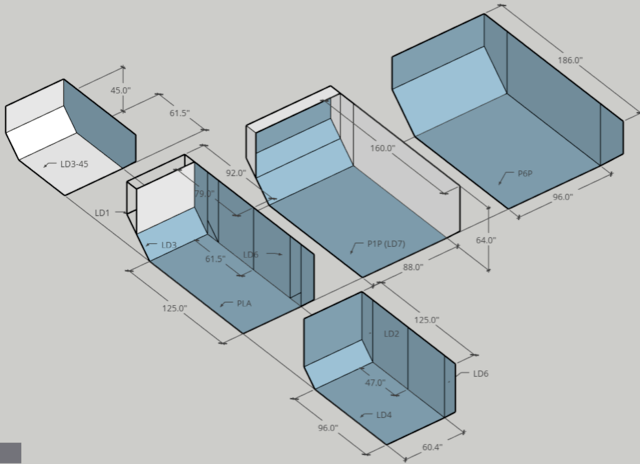
Aircraft compatibility
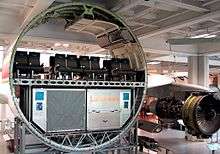
LD3s, LD6s, and LD11s will fit 787s, 777s, 747s, MD-11s, Il-86s, Il-96s, L-1011s and all Airbus wide-bodies. The 767 uses the smaller LD2s and LD8s because of its narrower fuselage. The less common LD1 is designed specifically for the 747, but LD3s are more commonly used in its place because of ubiquity (they have the same floor dimensions such that one LD3 takes the place of one LD1). LD3s with reduced height (1.143 metres (3.75 ft) instead of 1.63 metres (5.3 ft)) can also be loaded on the Airbus A320 family. LD7 pallets will fit 787s, 777s, 747s, late model 767s (with the big door), and Airbus wide-bodies.
Interchangeability of certain ULDs between LD3/6/11 aircraft and LD2/8 aircraft is possible when cargo needs to be quickly transferred to a connecting flight. Both LD2s and LD8s can be loaded in LD3/6/11 aircraft, but at the cost of using internal volume inefficiently (33 ft3 wasted per LD2). Only the LD3 of the LD3/6/11 family of ULDs can be loaded in a 767; it will occupy an entire row where two LD2s or one LD8 would otherwise have fit (90 ft3 wasted per LD3). Policies vary from airline to airline as to whether such transfers are allowed.
One of the design requirements of the 787 was that it use the LD3/6/11 family of ULDs to solve the wasted volume issue.
ULD capacity
| Deck | lower | main | ||||
|---|---|---|---|---|---|---|
| model | containers | 88×125″ | 96×125″ | 96×125″ | 88×125″ | 88x108″ |
| A300-600[4] | 22 LD3 | 4 + 10 LD3 | 4 + 10 LD3 | 20 | 21[5] | |
| A310[6] | 15 LD3 | 3 + 7 LD3 | 3 + 7 LD3 | 15 | 16[5] | |
| A319[7] | 4 LD3-45 | |||||
| A320[8] | 7 LD3-45 | 11[9] | ||||
| A321[10] | 10 LD3-45 | 14[9] | ||||
| A330-2/800[11] | 26 LD3 | 8 | 8 | 22 | 23 | 26 |
| A330-3/900[11] | 32 LD3 | 11 | 10 | 26 | 26[12] | |
| A340-200[13] | 26 LD3 | 9 | 9 | |||
| A340-300[13] | 32 LD3 | 11 | 10 | |||
| A340-500[14] | 30 LD3 | 10 | 10 | |||
| A340-600[14] | 42 LD3 | 14 | 14 | |||
| A350-900[15] | 36 LD3 | 11 | 11 | |||
| A350-1000[15] | 44 LD3 | 14 | 14 | |||
| A380-800[16] | 38 LD3 | 13 | 13 | |||
| B707-320C[17] | no lower ULD | 13 | 13 | |||
| B727-100C[18] | no lower ULD[lower-alpha 1] | 8 | 8 | |||
| B737-200C[19] | no lower ULD | 7 | 7 | |||
| B737-300SF[20] | no lower ULD | 9 | ||||
| B737-400SF[21] | no lower ULD | 10 ½ | ||||
| B737-700C[19] | no lower ULD | 8 | 8 | |||
| B737-800SF[22] | no lower ULD | 11 ½ | ||||
| B747 classic[23] | 30 LD1 | 28 | 28 | 36 | ||
| B747SP[23] | 20 LD1 | |||||
| B747-400[24] | 32 LD1 | 9 + 4 LD1 | 9 + 2 LD1 | 30 | 30 | |
| B747-8/8F[25] | 40 LD1 | 12 + 2 LD1 | 34 | |||
| B757-200F[26] | no lower ULD | 15 | ||||
| B767-200[27] | 22 LD2 | 3 + 10 LD2 | 3 + 10 LD2 | |||
| B767-300[27] | 30 LD2 | 4 + 14 LD2 | 4 + 14 LD2 | 14 | 16 | 26 |
| B767-400[27] | 38 LD2 | |||||
| B777-200[28] | 32 LD3 | 10 + 2 LD3 | 10 | 27 | ||
| B777-300[28] | 44 LD3 | 14 + 2LD3 | 14 | |||
| B777-9[29] | 48 LD3 | 16 | 14 + 4 LD3 | |||
| B787-8[30] | 28 LD3 | 9 | 8 + 2 LD3 | |||
| B787-9[30] | 36 LD3 | 11 | 11 | |||
| B787-10[30] | 40 LD3 | 13 | 13 | |||
| DC-8-55F[31] | no lower ULD | 13 | ||||
| DC-8-62/72F[31] | no lower ULD | 14 | ||||
| DC-8-61/63/71/73F[31] | no lower ULD | 18 | ||||
| DC-9-15F[32] | no lower ULD | 6 | ||||
| DC-9-32F[32] | no lower ULD | 8 | ||||
| MD-80SF[33] | no lower ULD | 8 | 8 | 12 | ||
| DC-10[34] | 26 LD3 | 5 + 8 LD3 | 22 | 30 | ||
| MD-11[35] | 32 LD3 | 6 + 14 LD3 | 26 | 26 | 34 | |
| L-1011[36] | 19 LD3 | 4 + 7 LD3 | ||||
| Il-86/Il-96-300[37] | 16 LD3 | |||||
| Il-96M/T[38] | 32 LD3 | |||||
- ↑ The B727-200 had an option to hold 11 specific 45.5 in–92.4 in × 41.1 in × 43.4 in (1.16 m–2.35 m × 1.04 m × 1.10 m) base-full width x height x depth, 78 cu ft (2.2 m3) underfloor containers.
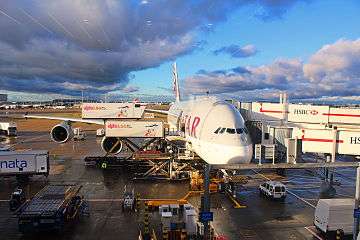
Aircraft loads can consist of containers, pallets, or a mix of ULD types, depending on requirements. In some aircraft the two types must be mixed as some compartments take only specific ULDs.
Container capacity of an aircraft is measured in positions. Each half-width container (LD1/LD2/LD3) in the aircraft it was designed for occupies one position. Typically, each row in a cargo compartment consists of two positions. Therefore, a full-width container (LD6/LD8/LD11) will take two positions. An LD6 or an LD11 can occupy the space of two LD3s. An LD8 takes the space of two LD2s.
Aircraft pallet capacity is measured by how many PMC-type LD7s 96 by 125 in (240 by 320 cm) can be stored. These pallets occupy approximately three LD3 positions (it occupies two positions of one row and half of the two positions of the following row) or four LD2 positions. PMCs can only be loaded in cargo compartments with large doors designed to accept them (small door compartments are container only).
Identification
All ULDs are identified by their ULD number. A three-letter prefix identifies its type, followed by a 4 or 5 digit serial number (4 if prior to October 1, 1993; either 4 or 5 if after October 1, 1993) to uniquely identify it from others of the same type, and ending with a two character (alpha-numerical) suffix identifying the ULD's owner (if an airline, often the same as IATA designator codes). For example, AKN 12345 DL means that the ULD is a forkliftable LD3 with the unique number 12345 and its owner is Delta Air Lines.[39] IATA uses three letter codes (in upper case letters) to describe key characteristics of ULDs.
First letter
The meaning of the first letter is
- A Certified Aircraft Container
- D Non-Certified Aircraft Container
- F Non-Certified Aircraft Pallet
- G Non-Certified Aircraft Pallet Net
- J Thermal Non-Structural Igloo
- H Horse Stalls
- K Cattle Stalls
- M Thermal Non-Certified Aircraft Container
- N Certified Aircraft Pallet Net
- P Certified Aircraft Pallet
- R Thermal Certified Aircraft Container
- U Non-Structural Container
- V Automobile Transport Equipment
Second letter
The second letter describes the base size of the container.
- A 2,235 mm × 3,175 mm (88 in × 125 in)
- B 2,235 mm × 2,743 mm (88 in × 108 in)
- E 1,346 mm × 2,235 mm (53 in × 88 in)
- F 2,438 mm × 2,991 mm (96.0 in × 117.8 in)
- G 2,438 mm × 6,058 mm (96.0 in × 238.5 in)
- H 2,438 mm × 9,125 mm (96.0 in × 359.3 in)
- J 2,438 mm × 12,192 mm (96 in × 480 in)
- K 1,534 mm × 1,562 mm (60.4 in × 61.5 in)
- L 1,534 mm × 3,175 mm (60 in × 125 in)
- M 2,438 mm × 3,175 mm (96 in × 125 in)
- N 1,562 mm × 2,438 mm (61.5 in × 96.0 in)
- P 1,198 mm × 1,534 mm (47.2 in × 60.4 in)
- Q 1,534 mm × 2,438 mm (60.4 in × 96.0 in)
- R 2,438 mm × 4,938 mm (96.0 in × 194.4 in)
- X Miscellaneous sizes largest dimension between 2,438 and 3,175 mm (96 and 125 in)
- Y Miscellaneous sizes largest dimension2,438 mm (96 in)
- Z Miscellaneous sizes largest dimension >3,175 mm (125 in)
Common prefixes
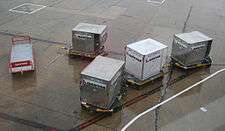

- AAA: LD7 container (88 in × 125 in or 2,235 mm × 3,175 mm), 81 in (2,057 mm) tall, contoured for maindeck narrow-body
- AAD: LD7 container (88 in × 125 in or 2,235 mm × 3,175 mm), 96 in (2,438 mm) tall, contoured for maindeck wide-body (aka A1)
- AAF:[40] LD26 container
- AAP:[40] LD9
- AAU:[40] LD29 container
- AAY: LD7 container (88 in × 125 in or 2,235 mm × 3,175 mm), 81 in (2,057 mm) tall, contoured for maindeck wide-body and narrow-body (aka A2)
- AAZ: LD7 container (88 in × 125 in or 2,235 mm × 3,175 mm), 64 in (1,626 mm) tall, contoured for maindeck wide-body and narrow-body and any belly (aka L9)
- AGA:[40] M2 container
- AKC:[40] LD1 without forklift holes
- AKE:[40] LD3 without forklift holes/half ALF
- AKH, AKW: LD3-45 mainly for A320/321, 45 in (1,143 mm) tall, same base as AKE, extensions on both sides
- AKN:[40] LD3 with forklift holes
- ALB:[40] LD4 with forklift holes
- ALD: LD11 container (aka L11)
- ALF:[40] LD6 without forklift holes
- ALP:[40] LD11 without forklift holes
- ALP:[40] LD4 without forklift holes
- AMA:[40] M1 container
- AMD:[40] M1H container
- AMJ: LD7 container (96 in × 125 in or 2,438 mm × 3,175 mm), 96 in (2,438 mm) tall, contoured for main deck wide-body (aka M1)
- AMU:[40] LD39 container contour similar to ALF, but deeper and bigger extensions. biggest lower-deck container
- AVY:[40] LD1 with forklift holes
- AWC:[40] LD6 with forklift holes
- AYY:[40] Demi, a half-width contoured container typically used for the main deck
- AYX:[40] AYY with fittings to connect a fire extinguisher so as to carry Dangerous Goods
- DPE:[40] LD2 without forklift holes
- DPN:[40] LD2 with forklift holes
- DQF:[40] LD8 with forklift holes
- FLA:[40] LD11 pallet
- FQA: LD8 pallet (same floor dimensions as DQF)
- HMA:[40] Horse stall
- KMA:[40] Sheep and goat pen
- P1P:[40] LD7, large pallet (88 in × 125 in or 2,235 mm × 3,175 mm), folding wings for overhang
- PAD:[40] LD7, large pallet (88 in × 125 in or 2,235 mm × 3,175 mm), flat
- PGA:[40] M6, large pallet (96 in × 238.5 in or 2,438 mm × 6,058 mm), freighter main deck only
- PLA:[40] LD11 pallet
- PMC: LD7, large pallet (96 in × 125 in or 2,438 mm × 3,175 mm)
- QKE: LD3 same as AKE but made of KEVLAR and designed to be bombproof. No forklift holes.
- RAP:[40] LD9 with refrigeration unit
- RAU:[40] LD29 container with refrigeration unit
- RKN:[40] LD3 with refrigeration unit
- RWB:[40] LD11 with refrigeration unit
- SAA: Full-sized version of the AYY
- SAX: Full-sized version of the AYX
- VRA:[40] M6, large pallet (96 in × 196 in or 2,438 mm × 4,978 mm), twin car rack
- XAW:[40] LD7, large pallet (88 in × 125 in or 2,235 mm × 3,175 mm), fixed wings for overhang
- XKC: LD3 without forklift holes/half ALF
Position 1 letter identifies ULD category (certification, ULD type, thermal units);[39]
Position 2 letter identifies standard base dimensions:[39]
Position 3 letter identifies contour, forklift holes, and other miscellaneous information.[39]
Main-deck ULDs
On the main deck of cargo planes are 79 to 96 inches (2,007 to 2,438 mm) tall ULDs with footprints similar to those of 88 inches (2,235 mm) or 96 inches (2,438 mm) wide pallets and 62 inches (1,575 mm) or 125 inches (3,175 mm) long. A 62-inch (1,575 mm) wide x 88-inch (2,235 mm) tall ULD is half the volume of a 125-inch (3,175 mm) x 88 inch pallet. The 20 foot pallet is 238 inches (6,045 mm) long and 96 inches (2,438 mm) wide. What the actual dimensions of contoured upper deck ULDs are is very hard to know, because most manufacturers only profile width, length and height data.
There are several common types of contoured main deck ULDs, that are contoured (curved to fit in the plane's body) to provide as much cargo volume as possible. Initially ULD contouring was simply a triangle removed from one or two corners of the profile of the ULD, such as the common LD3 and LD6. Main deck ULDs use curves for the contoured shape to truly maximize cargo volume. Upper deck ULDs are just like lower deck ULDs that are either the full width of the plane with two corners of the profile removed (lower deck LD6 lower), or that container is cut in half, down the center line of the plane, (lower deck LD3 and upper deck AAX).
Main deck ULDs and pallets are not only taller than lower deck ULDs, they are frequently two or four times longer. They are usually organized like an LD6, using the width of the plane and missing two profile corners, or two very long LD3s, stored in parallel to use the plane's width and each missing one profile corner, but often twice or four times as long from plane's nose to tail.
Many air cargo companies use main deck ULDs that have both features called dual-profile, so that on smaller planes such as the Boeing 727, they are stored widthwise and have two corners contoured, and on the bigger Boeing 767, they can be rotated 90 degrees and shipped in parallel like LD3s, so that only one corner is contoured when being used like an LD3. This greatly simplifies transportation of cargo containers at slight cost of cargo volume.
See also
- 463L master pallet, used for military aircraft transport and airdrops
- AAR Corp, parent company of Nordisk Aviation, a manufacturer of ULDs
- Containerization
- Intermodal container
- Pallet
- Rio Tinto Alcan, formerly Alusuisse, a manufacturer of ULDs
- Shipping container
- Unit load
References
- ↑ "ULD Regulations". IATA.
- ↑ "Pallets and containers" (PDF). Boeing. 2012.
- ↑ "AKH (LD3-45)". Nordisk Aviation.
- ↑ "A300-600 Aircraft Characteristics - Airport and Maintenance Planning" (PDF). Airbus. Dec 2009.
- 1 2 "A300/A310 P2F" (PDF). Elbe Flugzeugwerke.
- ↑ "A310 Aircraft Characteristics - Airport and Maintenance Planning" (PDF). Airbus. Dec 2009.
- ↑ "A319 Aircraft Characteristics - Airport and Maintenance Planning" (PDF). Airbus. Feb 2018.
- ↑ "A320 Aircraft Characteristics - Airport and Maintenance Planning" (PDF). Airbus. Feb 2018.
- 1 2 "A320/A321 P2F" (PDF). Elbe Flugzeugwerke.
- ↑ "A321 Aircraft Characteristics - Airport and Maintenance Planning" (PDF). Airbus. Feb 2018.
- 1 2 "A330 Aircraft Characteristics - Airport and Maintenance Planning" (PDF). Airbus. Jul 2018.
- ↑ "A330P2F" (PDF). Elbe Flugzeugwerke.
- 1 2 "A340-200/300 Aircraft Characteristics - Airport and Maintenance Planning" (PDF). Airbus. Jul 2018.
- 1 2 "A340-500/600 Aircraft Characteristics - Airport and Maintenance Planning" (PDF). Airbus. Jul 2018.
- 1 2 "A350-900/1000 Aircraft Characteristics - Airport and Maintenance Planning" (PDF). Airbus. Jun 2018.
- ↑ "A380 Aircraft Characteristics - Airport and Maintenance Planning" (PDF). Airbus. Dec 2016.
- ↑ "707 Airplane Characteristics for Airport Planning" (PDF). Boeing. May 2011.
- ↑ "727 Airplane Characteristics for Airport Planning" (PDF). Boeing. May 2011.
- 1 2 "737 Airplane Characteristics for Airport Planning" (PDF). Boeing. Sep 2013.
- ↑ "B737-300SF Freighter Conversion" (PDF). Aeronautical Engineers.
- ↑ "B737-400SF Freighter Conversion" (PDF). Aeronautical Engineers.
- ↑ "B737-800SF Freighter Conversion" (PDF). Aeronautical Engineers.
- 1 2 "747-100/200/300/SP Airplane Characteristics for Airport Planning" (PDF). Boeing. May 2011.
- ↑ "747-400/-400ER Freighters" (PDF). Boeing. May 2010.
- ↑ "747-8/8F Airplane Characteristics for Airport Planning" (PDF). Boeing. Dec 2012.
- ↑ "757 Airplane Characteristics for Airport Planning" (PDF). Boeing. May 2011.
- 1 2 3 "767 Airplane Characteristics for Airport Planning" (PDF). Boeing. May 2011.
- 1 2 "777 Airplane Characteristics for Airport Planning" (PDF). Boeing. May 2015.
- ↑ "777-9 Airplane Characteristics for Airport Planning" (PDF). Boeing. May 2015.
- 1 2 3 "787 Airplane Characteristics for Airport Planning" (PDF). Boeing. March 2018.
- 1 2 3 "DC-8 Airplane Characteristics for Airport Planning" (PDF). McDonnell Douglas. May 2011.
- 1 2 "DC-8 Airplane Characteristics for Airport Planning" (PDF). McDonnell Douglas. May 2011.
- ↑ "MD-80SF Freighter Conversion" (PDF). Aeronautical Engineers.
- ↑ "DC-10 Airplane Characteristics for Airport Planning" (PDF). McDonnell Douglas. May 2011.
- ↑ "MD-11 Airplane Characteristics for Airport Planning" (PDF). McDonnell Douglas. May 2011.
- ↑ "L-1011-500 TriStar technical profile" (PDF). Lockheed.
- ↑ Gerard Frawley. "Ilyushin Il-86". The International Directory of Civil Aircraft – via Airliners.net.
- ↑ Gerard Frawley. "Ilyushin Il-96M & Il-96T". The International Directory of Civil Aircraft – via Airliners.net.
- 1 2 3 4 "Guide to Air Freight Containers". World Trade Press. 2000. Archived from the original on 2016-03-25. Retrieved 2016-11-02.
- 1 2 3 4 5 6 7 8 9 10 11 12 13 14 15 16 17 18 19 20 21 22 23 24 25 26 27 28 29 30 31 32 33 34 "Boeing Cargo" Archived February 13, 2015, at the Wayback Machine., Boeing, March 2012.
External links
| Wikimedia Commons has media related to Unit load devices. |
- "Pallets and containers" (PDF). Boeing. 2012.